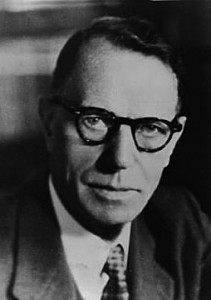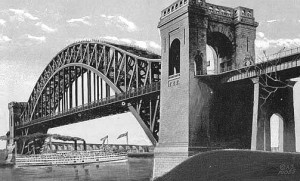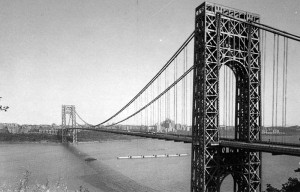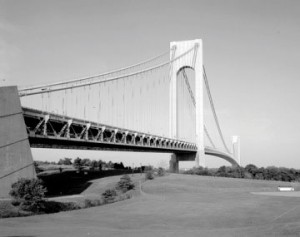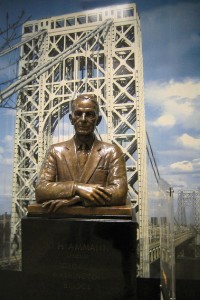Ammann was born on March 26, 1879, in Schaffhausen, Switzerland, the home of the famous 18th century Grubenman wooden bridge. His family was of moderate means with his father in manufacturing and his mother in hat making. At an early age he showed an aptitude for mathematics and began studying for a civil engineering degree at the Polytechnikum in Zürich, Switzerland. He graduated in 1902. The college, now named the Swiss Federal Institute of Technology, was founded in 1854 and was one of the leading schools of science and engineering at that time. He studied under Wilhelm Ritter who visited the United States in 1893 to observe engineering works and described them in his lectures. After graduating, Ammann worked on railroad layout and in 1903-04 he worked in Frankfurt, Germany on reinforced concrete structures. In 1904, Othmar came to the United States for what he thought would be a few years to work on the major projects he had heard about while in college. He fortunately found a position with the Union Bridge Company under Charles Macdonald and his engineer Joseph Mayer. The company was building some of the major bridges in the country, such as Macdonald’s proposal for a 2,400-foot span cantilever railroad bridge across the Hudson River. With mentors like Mayer and Macdonald, Ammann quickly learned the U.S. methods of building bridges fast and inexpensively. He then moved to Harrisburg, Pennsylvania for a short time to work with the Pennsylvania Steel Company under Frederick Kunz. Then Othmar worked with Gustav Lindenthal as Consulting Engineer to the Department of Bridges in New York City. The Pennsylvania Steel Company was in the process of building the Queensboro (Blackwell’s Island) Bridge at the time. Amman briefly returned to Switzerland to marry Lilly Selma Wehrli and then returned to Harrisburg. He spent a short time at McClintic/Marshall followed by a stint with Ralph Modjeski in Chicago working on bridges for the Oregon Trunk Railroad, including a 340-foot span arch bridge over the Columbia River. He assisted C. C. Schneider in writing a report on the collapse of the Quebec Cantilever Bridge. As a result of the Quebec failure, Kunz and Ammann wrote a report confirming the safety of the Queensboro Bridge and its design.
Between 1909 and 1912, Ammann worked with the newly formed firm, Kunz & Schneider Consulting Engineers, in Philadelphia, Pennsylvania. One of their major projects was an arch bridge across the Reversing Falls at St. John, New Brunswick.
In 1912, he was hired by Gustav Lindenthal as his chief assistant on the design of the Hell Gate Arch Bridge. Lindenthal was selected as Chief Engineer for the New York Connecting Railroad, which included the Hell Gate Bridge, as well as Chief Engineer for a bridge across the Hudson River. The Hell Gate Bridge was the longest span arch bridge in the world at the time, and Ammann was in charge of its design and construction, with David B. Steinman as his assistant. The threat of war in Switzerland resulted in Ammann returning to his homeland as an Army Lieutenant in the summer of 1914. Lindenthal advanced Steinman to Ammann’s position. The threatened war did not occur, and Ammann returned to his position and Steinman was demoted. The shift resulted in a bitter rivalry between the two men until Ammann’s death.
Lindenthal proposed a bridge across the Hudson River as early as 1885. Due to financing and other concerns, it never got past a groundbreaking in 1895. In 1920 he, with Ammann’s design help, proposed a huge bridge at 57th Street for railroads, motor vehicles and rapid transit costing in excess of $100,000,000. Financing was slow, and Lindenthal and Ammann, with Steinman’s help, designed the Sciotoville Continuous Truss bridge across the Ohio River. It was the longest span truss bridge in the country at the time (1922). Lindenthal sent Ammann to Portland, Oregon where he had received a contract to design three bridges across the Willamette River. The Ross Island Bridge was a cantilever, the Burnside Bridge was a truss bridge with bascule span and the Sellwood Bridge a continuous truss. Each bridge was unique. Designed in 1922 to 1923, they were built between 1925 and 1926.
In 1923, when Ammann returned to the New York office of Lindenthal, work was proceeding on the Hudson River Bridge. There were growing concerns that the bridge was too large and the approaches would take too much land and cost too much. Lindenthal, however, was convinced that a bridge of this size and at this location was absolutely necessary. Ammann went to Lindenthal suggesting that a smaller bridge aimed primarily at automobiles and located farther up the river would receive the necessary support from the city and states. Lindenthal accused Ammann of “timidity and shortsightedness”, and that he was “looking ahead for 1,000 years.” On March 23, 1923 Ammann left Lindenthal and set up his own office in New York City.
He worked primarily on his own design for the Hudson River Bridge with no client to pay the bills. It would be at 179th Street between Fort Lee (New Jersey) and Fort Washington (New York), have a span of 3,500 feet and carry eight lanes of automobile and truck traffic. It would be built for under $40,000,000. He first proposed his design at a meeting of the Connecticut Society of Civil Engineers on February 19, 1924 and sent his plan to Governor Silzer of New Jersey. Silzer sent Ammann’s drawings and proposal to the press, including The Engineering Record that published them with a small drawing and brief description in the January 3, 1924 issue. The article mentioned the drawings were by Ammann, and the bridge was estimated to cost $30,000,000 and would connect with the Washington Arch Bridge over the Harlem River to provide “direct access to the Bronx Borough and to highways leading to New England without entering New York’s intensive traffic area.” With the support of New Jersey and New York, Ammann’s design was accepted and placed under the Port Authority of New York with Ammann designated as Chief Bridge Engineer for the Authority. The bridge was built between 1927 and 1931, and opened October 24, 1931.
At the same time he was designing the George Washington Bridge, Ammann was also designing the Bayonne Arch Bridge over the Kill Van Kull leading to Staten Island. It was then the longest span arch bridge in the world (1,652 feet). He also supervised construction of two bridges across the Arthur Kill, the Goethals and Outerbridge, both of which were designed by J. A. L. Waddell.
In 1923, Othmar was appointed Chief Engineer of the Triborough Bridge Authority under the legendary Robert Moses. Moses planned a major project consisting of a 1,380-foot span suspension bridge over the East River, 1,600 feet of truss bridge, a 770-foot long lift bridge and 3½ miles of viaduct. The project was built between 1934 and 1936. This was followed by the Bronx-Whitestone Bridge. It was a 2,300-foot span suspension bridge and opened in 1939 in time for the New York Worlds Fair. While designing these bridges, Ammann maintained his position with the New York Port Authority. At the same time, he was one of the consultants to Joseph B. Strauss on the design and construction of the Golden Gate Bridge in San Francisco. Strauss also consulted with Ammann on his George Washington and Bayonne Bridges. The Golden Gate Bridge, with its 4,200-foot span, surpassed the George Washington Bridge by 700 feet to become the longest suspension bridge in the world at the time. It opened in 1937. He also consulted with one of his early mentors, Ralph Modjeski, on his Benjamin Franklin (originally the Delaware River) Suspension Bridge across the Delaware River that opened up July 1, 1926. Its 1,750 foot span was the longest in the United States at the time.
In 1939, Ammann resigned from the Port Authority and set up a partnership with C. C. Combs, a well-known landscape architect. Highway work made up most of their efforts in the first years. Their first bridge work was a pedestrian lift bridge to Ward’s Island in the East River. Ammann called this his “Little Green Bridge”. It had a lift span of 312 feet. Due to financing, it did not open until 1951. This was followed by a survey of the Brooklyn Bridge in 1941. He reported the bridge was in excellent condition. He was appointed chairman of a three man commission, with Theodore VanKarman and Glenn Woodruff, to report on the failure of the Tacoma Narrows Suspension bridge, designed by Leon Moisseff, which fell November 7, 1940 shortly after it opened. They found the long slender deck, designed using the deflection theory, was susceptible to aerodynamic forces that led to the observed oscillation. With this information, Ammann stiffened his Bronx-Whitestone Bridge in 1946.
In 1947, the partnership of Ammann and Combs came to an end, and Ammann formed a new company, Ammann & Whitney Consulting Engineers. Whitney was a well known expert on reinforced concrete. Much of their work came from Ammann’s New York contacts. In 1956, Moses hired the firm to design the Throgs Neck suspension bridge across the East River. The span was 1,800 feet, and it opened January 11, 1964. In 1957, Othmar was called back to his first bridge, the George Washington, to add the lower deck that he had provided for back in the late 1920s. It was added between 1958 and 1961, without stopping traffic on the original bridge. He was asked to serve on a panel of engineers in 1947, with his long time competitor David Steinman, on the Mackinac Bridge connecting the upper and lower peninsulas of Michigan. In 1951, the commission rejected a tunnel but determined a bridge was feasible. The earlier design by Modjeski and Masters was rejected, and a new design was sought. Initially Ammann was selected by the Board, but his fee was considered excessive and the contract was given to Steinman.
The culmination of his bridge career came when he was selected to design the Verrazano Narrows Bridge between Brooklyn and Staten Island. David B. Steinman also planned a bridge he called the Liberty Bridge at the site as early as 1926. Ammann started his design in 1948. Due to financing, he did not start work until the mid 1950s. The span of the bridge would be 4,260 feet, surpassing the Golden Gate Bridge by 60 feet. Its upper deck opened November 24, 1961 and its lower deck June 28, 1968. When the Verrazano Narrows Bridge opened, Ammann was 80 years old. At its dedication, the Mayor of the City stated the bridge was “a structure of breathtaking beauty and super engineering.”
Throughout his career, Ammann had as a guiding philosophy, “Economics and utility are not the engineers only concerns. He must temper his practicality with aesthetic sensitivity. His structures should please the eye. In fact, an engineer designing a bridge is justified in making a more expensive design for beauty’s sake alone. After all, many people will have to look at the bridge for the rest of their lives. Few of us appreciate eyesores, even if we should save a little money in building them.” The story of Ammann and his New York Bridges is told in Six Bridges, The Legacy of Othmar H. Ammann by Darl Rastorfer. Ammann died September 23, 1965 at the age of 86 with the New York Times calling him “one of the great bridge builders of this century.” He had won many accolades over the years, but his most significant was the National Medal of Science granted him by President Lyndon Johnson in 1964. He was the first civil engineer to be honored in this way; he was awarded the honor under the classification of Behavioral and Social Sciences. His citation stated, “For a half century of distinguished leadership in the design of great bridges which combine beauty and utility with bold engineering concept and method…” Edward Cohen, a long time associate with Ammann & Whitney, wrote, “The outstanding characteristic of Ammann’s design is simplicity; he was the enemy of the ornate, the complicated, the extravagant, the ponderous.”
His image lives on in a bronze bust that was unveiled in the George Washington Bridge Bus Station in 1962, coinciding with the dedication of its lower level. It is passed by thousands every day, but few know the story of the man behind Six Bridges of New York City.▪

